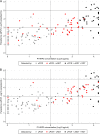Operational Performance of a Plasmodium falciparum Ultrasensitive Rapid Diagnostic Test for Detection of Asymptomatic Infections in Eastern Myanmar
- PMID: 29898998
- PMCID: PMC6062819
- DOI: 10.1128/JCM.00565-18
Operational Performance of a Plasmodium falciparum Ultrasensitive Rapid Diagnostic Test for Detection of Asymptomatic Infections in Eastern Myanmar
Abstract
In the Greater Mekong Subregion in Southeast Asia, malaria elimination strategies need to target all Plasmodium falciparum parasites, including those carried asymptomatically. More than 70% of asymptomatic carriers are not detected by current rapid diagnostic tests (RDTs) or microscopy. An HRP2-based ultrasensitive RDT (uRDT) developed to improve the detection of low-density infections was evaluated during prevalence surveys within a malaria elimination program in a low-transmission area of eastern Myanmar. Surveys were conducted to identify high-prevalence villages. Two-milliliter venous blood samples were collected from asymptomatic adult volunteers and transported to the laboratory. Plasmodium parasites were detected by RDT, uRDT, microscopy, ultrasensitive qPCR (uPCR), and multiplex enzyme-linked immunosorbent assay (ELISA). The sensitivity, specificity, and predictive positive and negative values of RDT and uRDT were calculated compared to uPCR and ELISA. Parasite and antigen concentrations detected by each test were defined using uPCR and ELISA, respectively. A total of 1,509 samples, including 208 P. falciparum-positive samples were analyzed with all tests. The sensitivity of the uRDT was twofold higher than that of RDT, 51.4% versus 25.2%, with minor specificity loss, 99.5% versus 99.9%, against the combined reference (uPCR plus ELISA). The geometric mean parasitemia detected by uRDT in P. falciparum monospecific infections was 3,019 parasites per ml (95% confidence interval [95% CI], 1,790 to 5,094; n = 79) compared to 11,352 parasites per ml (95% CI, 5,643 to 22,837; n = 38) by RDT. The sensitivities of uRDT and RDT dropped to 34.6% and 15.1%, respectively, for the matched tests performed in the field. The uRDT performed consistently better than RDT and microscopy at low parasitemias. It shows promising characteristics for the identification of high-prevalence communities and warrants further evaluation in mass screening and treatment interventions.
Keywords: Plasmodium falciparum; asymptomatic infection; low density parasitemia; low transmission setting; malaria; rapid tests; ultrasensitive RDT.
Copyright © 2018 Landier et al.
Figures





References
-
- Imwong M, Suwannasin K, Kunasol C, Sutawong K, Mayxay M, Rekol H, Smithuis FM, Hlaing M, Tun KM, Van Der Pluijm RW, Tripura R, Miotto O, Menard D, Dhorda M, Day NPJ, White NJ, Dondorp AM. 2017. The spread of artemisinin-resistant Plasmodium falciparum in the Greater Mekong Subregion: a molecular epidemiology observational study. Lancet Infect Dis 17:491–497. doi:10.1016/S1473-3099(17)30048-8. - DOI - PMC - PubMed
-
- Rabinovich RN, Drakeley C, Djimde AA, Hall BF, Hay SI, Hemingway J, Kaslow DC, Noor A, Okumu F, Steketee R, Tanner M, Wells TNC, Whittaker MA, Winzeler EA, Wirth DF, Whitfield K, Alonso PL. 2017. malERA: an updated research agenda for malaria elimination and eradication. PLoS Med 14:1–17. doi:10.1371/journal.pmed.1002456. - DOI - PMC - PubMed
-
- Imwong M, Stepniewska K, Tripura R, Peto TJ, Lwin KM, Vihokhern B, Wongsaen K, von Seidlein L, Dhorda M, Snounou G, Keereecharoen L, Singhasivanon P, Sirithiranont P, Chalk J, Nguon C, Day NPJ, Nosten F, Dondorp A, White NJ. 2016. Numerical distributions of parasite densities during asymptomatic malaria. J Infect Dis 213:1322–1329. doi:10.1093/infdis/jiv596. - DOI - PMC - PubMed
-
- Smithuis FM, Kyaw M, Phe U, van der Broek I, Katterman N, Rogers C, Almeida P, Kager PA, Stepniewska K, Lubell Y, Simpson JA, White NJ. 2013. The effect of insecticide-treated bed nets on the incidence and prevalence of malaria in children in an area of unstable seasonal transmission in western Myanmar. Malar J 12:363. doi:10.1186/1475-2875-12-363. - DOI - PMC - PubMed
Publication types
MeSH terms
Substances
Grants and funding
LinkOut - more resources
Full Text Sources
Other Literature Sources
Medical

